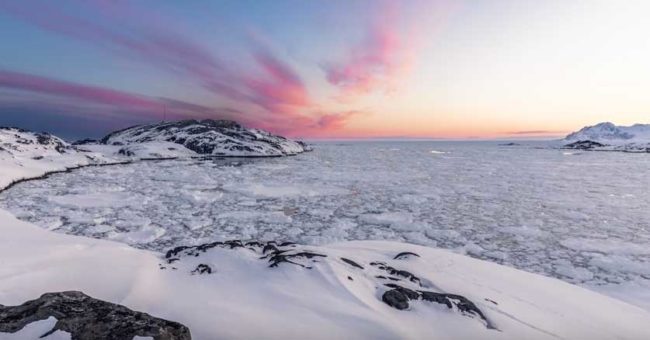
For the past 12 years now NOAA has been published an annual Arctic Report card and the 2017 issue is now available on-line.
The report card exists because something quite extraordinary has been happening in the Arctic and 2017 has not seen any pause in that.
Highlights
Arctic shows no sign of returning to reliably frozen region of recent past decades
Despite relatively cool summer temperatures, observations in 2017 continue to indicate that the Arctic environmental system has reached a ‘new normal’, characterized by long-term losses in the extent and thickness of the sea ice cover, the extent and duration of the winter snow cover and the mass of ice in the Greenland Ice Sheet and Arctic glaciers, and warming sea surface and permafrost temperatures.
- The average surface air temperature for the year ending September 2017 is the 2nd warmest since 1900; however, cooler spring and summer temperatures contributed to a rebound in snow cover in the Eurasian Arctic, slower summer sea ice loss, and below-average melt extent for the Greenland ice sheet.
- The sea ice cover continues to be relatively young and thin with older, thicker ice comprising only 21% of the ice cover in 2017 compared to 45% in 1985.
- In August 2017, sea surface temperatures in the Barents and Chukchi seas were up to 4° C warmer than average, contributing to a delay in the autumn freeze-up in these regions.
- Pronounced increases in ocean primary productivity, at the base of the marine food web, were observed in the Barents and Eurasian Arctic seas from 2003 to 2017.
- Arctic tundra is experiencing increased greenness and record permafrost warming.
- Pervasive changes in the environment are influencing resource management protocols, including those established for fisheries and wildfires.
- The unprecedented rate and global reach of Arctic change disproportionally affect the people of northern communities, further pressing the need to prepare for and adapt to the new Arctic.
Details
The actual report is detailed … very very detailed.
You can find a full PDF of it here.
Key Lesson from This Year
After a very warm Arctic-wide autumn 2016, spring and summer 2017 had near average air temperatures relative to the 1981-2010 climatology. If looked upon in isolation then that might suggest that things had returned to normal because these spring/summer conditions were reminiscent of conditions before the long-term temperatures increases that began in the 1990s.
However, when taken in context, there are many strong signals that continue to indicate that the Arctic environmental system has reached a ‘new normal’. While modulated by natural variability in regional and seasonal fluctuations, this ‘new normal’ is characterized by Arctic air temperatures that are warming at double the rate of the global temperature increase. Accordingly, there are pronounced decade-long declines in the extent and volume of the sea ice cover, the extent and duration of the winter snow cover, and the mass of the Greenland Ice Sheet and Arctic glaciers. Temperatures are increasing in the surface of the Arctic Ocean, contributing to later formation of the sea ice cover in the autumn. Temperatures are also increasing in the permafrost on the adjacent continents. Arctic paleo-reconstructions, which extend back millions of years, indicate that the magnitude and pace of the 21st century sea-ice decline and surface ocean warming is unprecedented in at least the last 1,500 years and likely much longer.
In Context – This has been happening
This one chart is a paleoclimate reconstructions of approximately 5-year mean values. It tells the story of what has suddenly happened. It comes from the section entitled “Paleoceanographic Perspectives on Arctic Ocean Change“
The section explain exactly how this reconstruction was created, and then presents you the results via this diagram …
The diagram illustrates the following for the past 1500 years …
- Black line at top is the qty of CO2 in the atmosphere
- Grey line is the sea surface temperature
- Red line is the air temperature
- Blue line is the sea ice extent … and yes, it has in the context of the longer term measurements, suddenly dropped off a cliff.
The Arctic plays an important role in the Earth’s climate; therefore, understanding and monitoring Arctic change is important to understanding and predicting global climate impacts.

